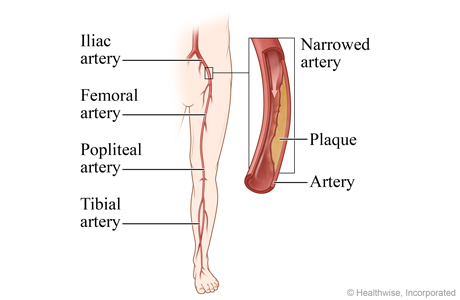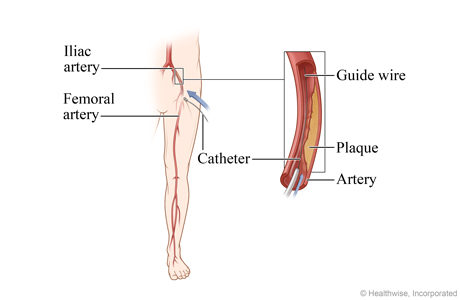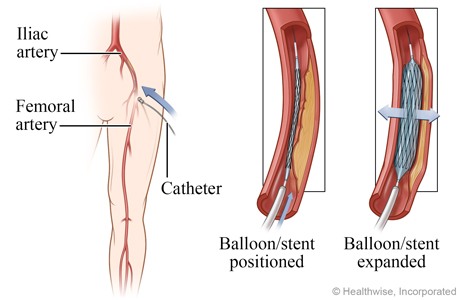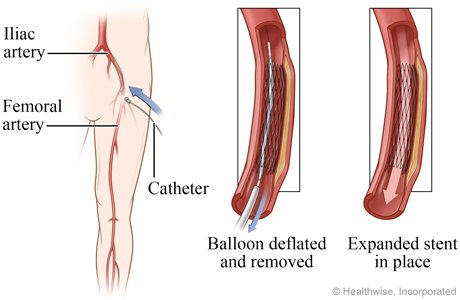Peripheral artery angioplasty: Overview
Peripheral artery angioplasty (say "puh-RIFF-er-rull AR-ter-ree ANN-jee-oh-plass-tee") is a procedure to treat peripheral arterial disease of the legs. The procedure widens narrowed arteries in the pelvis or legs. It can help blood flow better. This may decrease leg pain or help wounds heal better.
Your arteries can get narrowed by a substance called plaque. Plaque is a buildup of fats in your arteries.
You may be asleep for the procedure. Or you may be awake. You will get medicine to prevent pain and help you relax. First, your doctor will do a test to find narrowed arteries. Your doctor will put a tiny tube into an artery in your groin or wrist. This tube is called a catheter. The doctor moves the catheter through the artery and puts a dye into it. The dye makes your arteries show up on X-ray pictures. This lets the doctor see any narrowed parts of the arteries.
If your doctor finds a narrowed artery, they may do an angioplasty. To do this, the doctor uses a catheter with a balloon at the tip. It goes into the artery in your groin or leg. The doctor moves the balloon to the narrowed area and inflates it. The balloon presses the plaque against the walls of the artery. This makes more room for blood to flow. The doctor may also put a stent in your artery. A stent is a small tube that helps keep the artery open.
You may go home the same day. Or you may spend the night in the hospital. For 1 or 2 days after the procedure, you will need to take it easy at home.
Why is a peripheral artery angioplasty done?
This procedure is used to improve blood flow in narrowed arteries that supply blood to the legs and feet. It may be used on short sections of narrowed arteries in people who have peripheral arterial disease (PAD).
Angioplasty for peripheral arterial disease of the legs
Iliac artery is narrowed by plaque

Angioplasty is used to open narrowed arteries and increase oxygen-rich blood flow to muscle and tissue. These images show angioplasty for the iliac artery. Angioplasty can also be done for the femoral, popliteal, and tibial arteries.
Catheter is inserted

You may be asleep for the procedure. Or you may be awake. You will get medicine to prevent pain and help you relax. Then the doctor inserts a thin, flexible tube called a catheter into a blood vessel. In this image, the catheter is inserted into the femoral artery in the thigh and carefully guided to the narrowed part of the iliac artery. A wire inside the catheter is used to guide tools, including a small balloon, into the artery.
Balloon is inflated, stent is expanded

The doctor guides the catheter to the narrowed part of the artery and inflates a small balloon at the end of a tube. The balloon may remain inflated for a short time. If the doctor is going to place a stent in the artery, the balloon is inflated inside of the stent. The pressure from the inflated balloon causes the stent to expand and press the plaque against the wall of the artery, creating more room for blood to flow.
Balloon is removed, stent is in place

Next, the doctor deflates the balloon and removes it, leaving the expanded stent in place to keep the walls of the artery open.
Before and after angioplasty

Angioplasty can widen a narrowed part of an artery. This increases the flow of oxygen-rich and nutrient-rich blood to the leg.
After peripheral artery angioplasty: When to call
Call 911 anytime you think you may need emergency care. For example, call if:
- You passed out (lost consciousness).
- You have severe trouble breathing.
- You have sudden chest pain and shortness of breath, or you cough up blood.
Call your doctor now or seek immediate medical care if:
- You are bleeding from the area where the catheter was put in your artery.
- You have a fast-growing, painful lump at the catheter site.
- You have signs of infection, such as:
- Increased pain, swelling, warmth, or redness of the skin.
- Red streaks leading from the area.
- Pus draining from the area.
- A fever.
- Your leg or hand is painful, cold, tingly, or numb or looks pale, bluish, or purplish.
Watch closely for changes in your health, and be sure to contact your doctor if you have any problems.
©2011-2025 Healthwise, Incorporated
